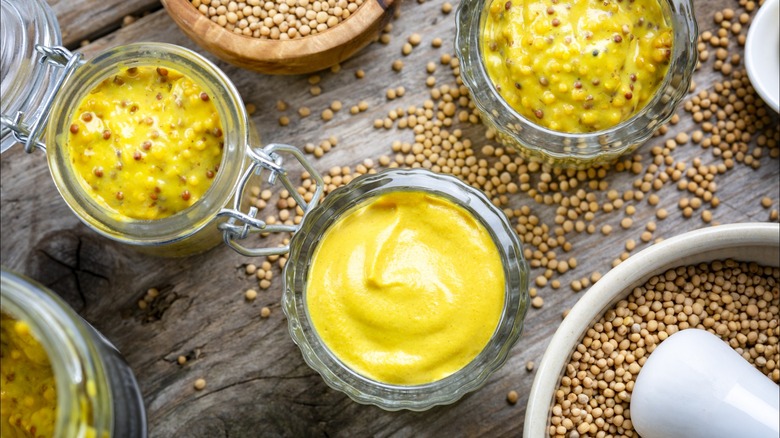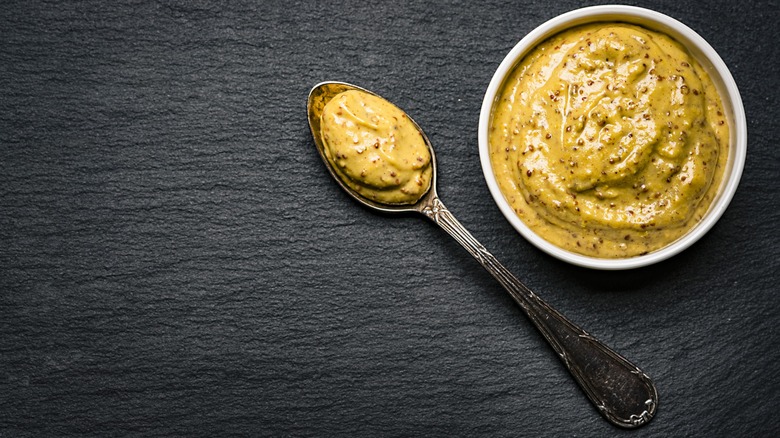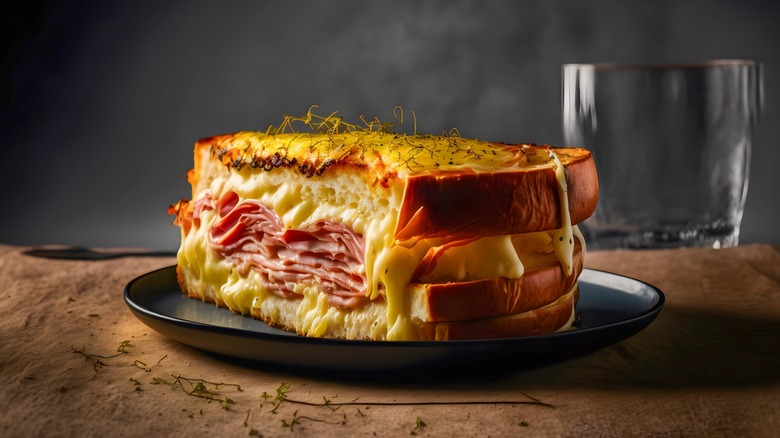Dijon Vs Spicy Brown Mustard: The Flavor Difference Explained
Mustard is a condiment that needs no introduction, for it's likely as familiar to your kitchen as salt and pepper. In fact, mustard is believed to have been used in some form since the days of the ancient Egyptians. But to limit the range of mustard in your refrigerator to the classic common yellow mustard would be a mistake. There are a variety of popular types of mustards out there, all ranging in bold and unique flavors. Of course this includes the yellow mustard that you know all too well, but it's worth shining the spotlight on some members of the mustard family that often fly under the radar. Most notably, it's worth paying attention to Dijon mustard and spicy brown mustard.
To the uninitiated, Dijon and spicy brown mustard might just fall into the category of "alternative" mustards to be used interchangeably in place of yellow mustard — especially if you're looking for something a little different than the usually bright yellow condiment. But this would be a mistake. There's actually a world of difference between Dijon and spicy brown mustard. For starters, they have some different key ingredients. Here's how they vary from one another in flavor, as well as how you might best utilize these condiments in your dishes.
What's the difference?
Although these two condiments come from the same general mustard family and therefore share the same basic philosophy for ingredients (mustard seeds, liquid, additional spices), that's about where the similarities end. Dijon is named after its town of origin in the wine-rich Burgundy region of France and is made using a tart ingredient called verjuice. Verjuice is made by pressing unripened fruits, usually wine grapes. The addition of this ingredient in making Dijon mustard gives the product only a light acidity compared to other mustards, which use stronger acids. The fruit product also lends some sweet and tangy notes to Dijon mustard, making it a real standout among its peers. Dijon mustard is also more refined and blended than most other mustards, making its texture quite smooth and even creamy.
Spicy brown mustard, on the other hand, is quite different from Dijon. Besides the apparent difference in color, spicy brown mustard is also distinguishable from Dijon mustard by its much coarser texture due to the mustard seeds remaining largely intact. As well, spicy brown mustard forgoes the verjuice found in Dijon and instead uses vinegar, yielding a much stronger and bolder acidity and amplifying the latent heat found in mustard seeds. This combination results in spicy brown mustard sharing flavor characteristics similar to other hot ingredients such as horseradish or wasabi, while Dijon is milder in comparison.
Finding the right use for each one
Since Dijon and spicy brown mustard are two distinct entities, you might want to ask which is better. But instead of comparing these on the basis of one being better than the other, it's worth realizing that both products are excellent if used for the right dishes. Dijon mustard, on account of its smooth texture and tart flavor profile, is an excellent ingredient in sauces, marinades, and vinaigrettes, and also features in excellent dishes such as the Monte Cristo sandwich. Spicy brown mustard, meanwhile, is best served less as a sauce and more like a spread by virtue of its coarser texture and more pungent taste. You may find spicy brown mustard in your local deli since its stronger flavors can hold their own against salty deli meats. It's also a staple as a spread on a charcuterie board for this same reason, and it fits right in when paired with salted crackers or a warm Bavarian pretzel.
Of course, no one is stopping you from swapping out these mustards if you're lacking one of them. After all, it seems that the only rule for food is that there are no hard and fast rules. Some people would rather not tackle the heat of spicy brown mustard, while others prefer it over Dijon entirely. What matters is that you know the difference between the two, you know their ideal uses, and now you can use this knowledge to implement one or both of these mustards in your culinary endeavors.


